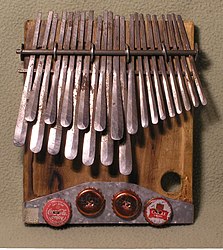 Mbira dzavadzimu | |
| Other instrument | |
|---|---|
| Other names | finger harp, gourd piano, ikembe, kalimba, kilembe, likembe, likimba, marimbula, mbla, sansa, sansu, sanza, thumb piano, timbrh, zanzu, finger piano |
| Classification | Lamellophone, Plucked Idiophone |
| Hornbostel–Sachs classification | 122.1 (Plucked idiophone) |
| Timbre | clear, percussive, chimelike |
| Volume | low |
| Attack | fast |
| Decay | moderate |
| Playing range | |
|
Varies, see Tuning low to medium | |
| Art of crafting and playing Mbira/Sansi, the finger-plucking traditional musical instrument in Malawi and Zimbabwe | |
|---|---|
| Country | Malawi and Zimbabwe |
| Reference | 01541 |
| Region | Africa |
| Inscription history | |
| Inscription | 2020 (15th session) |
| List | Representative |
Mbira (/əmˈbɪərə/ əm-BEER-ə) are a family of musical instruments, traditional to the Shona people of Zimbabwe. They consist of a wooden board (often fitted with a resonator) with attached staggered metal tines, played by holding the instrument in the hands and plucking the tines with the thumbs (at minimum), the right forefinger (most mbira), and sometimes the left forefinger. Musicologists classify it as a lamellaphone, part of the plucked idiophone family of musical instruments. In Eastern and Southern Africa, there are many kinds of mbira, often accompanied by the hosho, a percussion instrument. It is often an important instrument played at religious ceremonies, weddings, and other social gatherings. The "Art of crafting and playing Mbira/Sansi, the finger-plucking traditional musical instrument in Malawi and Zimbabwe" was added to the UNESCO Representative List of the Intangible Cultural Heritage of Humanity in 2020.[1]
A modern interpretation of the instrument, the kalimba, was commercially produced and exported by ethnomusicologist Hugh Tracey in the late 1950s, popularising similar instruments outside of Africa. Tracey's design was modelled after the mbira nyunga nyunga and named ''Kalimba'' after an ancient predecessor of the mbira family of instruments. The kalimba is basically a westernised younger version of mbira.[2] It was popularized in the 1960s and early 1970s largely due to the successes of such musicians as Maurice White of the band Earth, Wind and Fire and Thomas Mapfumo in the 1970s.[3] These musicians included mbira on stage accompanying modern rock instruments such as electric guitar and bass, drum kit, and horns. Their arrangements included numerous songs directly drawn from traditional mbira repertoire. Other notable influencers bringing mbira music out of Africa are: Dumisani Maraire, who brought marimba and karimba music to the American Pacific Northwest; Ephat Mujuru, who was one of the pioneer teachers of mbira dzavadzimu in the United States; and the writings and recordings of Zimbabwean musicians made by Paul Berliner.
Joseph H. Howard and Babatunde Olatunji have both suggested that mbira (and other metal lamellaphones) are thoroughly African, being found only in areas populated by Africans or their descendants.[4] Similar instruments were reported to be used in Okpuje, Nsukka area of the south eastern part of Nigeria in the early 1900s.[5]
- ^ "Art of crafting and playing Mbira/Sansi, the finger-plucking traditional musical instrument in Malawi and Zimbabwe". Intangible Cultural Heritage. UNESCO. Retrieved 11 September 2021.
- ^ "What is Kalimba". kalimbahq.com/. Retrieved 2022-04-24.
- ^ Cite error: The named reference
bbc2014was invoked but never defined (see the help page). - ^ Olatunji, Babatunde (1965). Musical Instruments of Africa: Their Nature, Use, and Place in the Life of a Deeply Musical People (1st ed.). New York, New York: John Day Company, Inc. p. 48. ISBN 0-381-97013-2.
- ^ "Sub-Saharan African Instruments at the National Music Museum". collections.nmmusd.org. Archived from the original on 2020-05-29. Retrieved 2020-05-29.